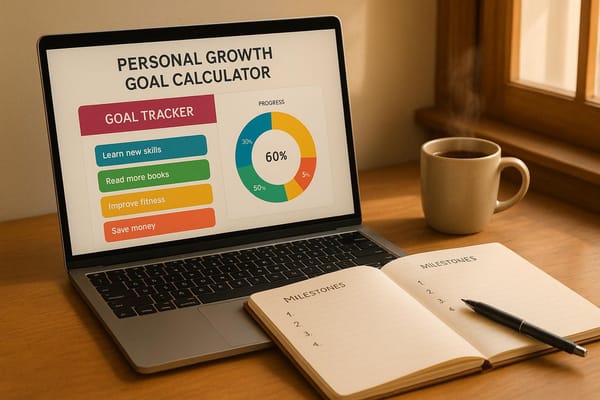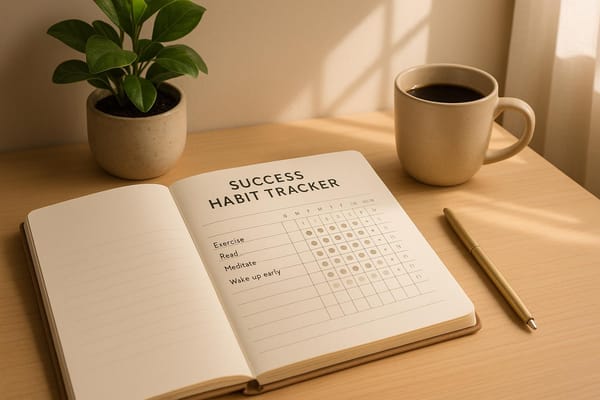Turning Self-Doubt into Growth Opportunities
Transform self-doubt into a powerful tool for personal growth by understanding its roots and adopting a constructive mindset.

Self-doubt is something everyone experiences, but it doesn’t have to hold you back. Instead, it can signal that you’re stepping out of your comfort zone - where growth happens. The key is learning to work with it, not against it.
Here’s how you can turn self-doubt into a tool for progress:
- Understand the root causes: Past failures, perfectionism, comparison, and imposter syndrome often fuel self-doubt.
- Challenge negative thoughts: Question your inner critic by looking for evidence and reframing doubts into constructive questions.
- Take small, actionable steps: Break goals into manageable tasks, focus on progress, and celebrate every step forward.
- Practice self-compassion: Treat yourself with the same kindness you’d show a friend.
- Adopt a growth mindset: View challenges as opportunities to learn, and see failure as feedback.
Self-doubt won’t disappear entirely, but you can learn to channel it into motivation. When faced with uncertainty, remember that it’s often a sign you’re on the path to growth.
Self-Doubt Holding You Back? Here’s How to Conquer It
How Self-Doubt Affects Your Life
Self-doubt has a sneaky way of weaving itself into every corner of your life. It’s there in the meeting room when you hold back from sharing your ideas, in your relationships when you wonder if you’re deserving of love, and in your personal aspirations when you convince yourself not to take that leap. Recognizing how this inner voice operates - and the ripple effects it creates - is the first step toward turning it into something constructive. Let’s break down what self-doubt really is and how it influences your actions.
What Self-Doubt Really Is
Self-doubt is like an internal critic that constantly questions your abilities, decisions, and value. It’s not just about feeling nervous before a big presentation or second-guessing a career move. It’s a deeper, persistent sense of uncertainty that can make you wonder if you’re truly capable of success.
It doesn’t look the same for everyone, though. For some, it’s that uneasy feeling in the pit of your stomach when you think about switching jobs. For others, it’s the voice that whispers, “You’re not good enough,” when you’re eyeing a promotion. Maybe it’s the hesitation keeping you from launching the business you’ve always dreamed about. It can even disguise itself as perfectionism - endlessly tweaking a project because it’s “not quite there yet” - or as procrastination, where fear of failure keeps you from starting at all.
The tricky part is that self-doubt often masquerades as rationality. Your mind highlights every possible failure, convincing you that holding back is the safe, logical choice. But there’s a big difference between healthy caution and paralyzing self-doubt. Healthy caution helps you prepare and make sound decisions. Self-doubt, on the other hand, traps you in a loop of “what ifs,” stopping you before you even begin.
The more you give in to self-doubt, the stronger it becomes. Avoiding risks reinforces the belief that you’re not capable, which only makes future decisions feel even harder.
Self-Doubt as a Growth Signal
Here’s the twist: self-doubt isn’t all bad. In fact, it often shows up when you’re stepping outside your comfort zone and tackling something new or challenging.
Think of it this way - self-doubt can be a clue that you’re on the verge of growth. That uneasy feeling? It’s a sign you’re about to stretch yourself, pick up new skills, or see things from a fresh perspective. Instead of viewing it as a roadblock, try reframing it as a signal that you’re entering a space where growth happens.
The trick is learning to tell the difference between self-doubt that helps you and self-doubt that holds you back. Productive self-doubt asks questions that lead to action: “What do I need to learn to succeed here?” or “How can I prepare better for this challenge?” It pushes you to research, practice, and seek advice. Destructive self-doubt, on the other hand, asks questions that undermine you: “What if I’m not good enough?” or “Why would anyone take me seriously?”
When you start seeing self-doubt as a growth signal, it can guide you toward areas where you need to improve. Nervous about public speaking? That might be the skill that could elevate your career. Hesitant about starting a side business? That doubt might be pointing to untapped entrepreneurial potential.
Of course, this perspective shift doesn’t make self-doubt any less uncomfortable. It’s still going to feel uncertain, even intimidating. But it changes how you interpret those feelings. Instead of seeing doubt as a reason to back away, you can recognize it as proof that you’re pushing yourself to grow.
The truth is, even the most accomplished people feel self-doubt. The difference is, they’ve learned to use it as a tool for progress. They don’t let it stop them - they let it drive them. Feeling uncertain doesn’t mean you’re off track. More often than not, it’s a sign that you’re exactly where you need to be.
Finding the Source of Your Self-Doubt
Pinpointing where your self-doubt comes from is key to addressing it. Self-doubt doesn’t just appear out of thin air - it’s often a result of experiences, messages, and patterns that have shaped how you see yourself over time. By understanding its roots, you can begin to challenge and overcome it.
Common Causes of Self-Doubt
Past failures and setbacks often play a major role in fueling self-doubt. Whether it’s a botched presentation, a job rejection, or a business venture that didn’t work out, these moments can leave a lingering sense of inadequacy that your mind tends to magnify.
Childhood messages can leave a lasting impression. If you grew up hearing things like “You’re not good enough” or “Don’t aim too high,” those messages can echo in your mind well into adulthood. Even parents with the best intentions - like frequently pointing out mistakes or offering constant corrections - can unintentionally contribute to limiting beliefs about your abilities.
Comparison culture has made self-doubt even more pervasive. Social media often presents a polished highlight reel of other people’s lives, making it easy to feel like you’re falling short. When you’re dealing with your own struggles behind the scenes, it’s tempting to believe that everyone else is more capable, confident, or deserving of success.
Perfectionism sets the bar impossibly high, making self-doubt almost inevitable. If your standards are so unrealistic that anything less than flawless feels like failure, it’s easy to get stuck in a cycle of hesitation and second-guessing. Perfectionism often tricks you into thinking that if you can’t do something perfectly, you shouldn’t do it at all.
Negative feedback and criticism can leave a lasting mark. A harsh performance review, a critical teacher, or even a friend’s offhand comment can linger for years, shaping how you approach challenges and reinforcing feelings of self-doubt.
Imposter syndrome is another common source, often tied to rapid success or being in an environment where you feel out of place. When you land an opportunity that feels “too good” for you, self-doubt can creep in, whispering that it’s only a matter of time before you’re exposed as unqualified.
Building Self-Awareness
Understanding where your self-doubt comes from is the first step toward turning it into a tool for growth. Once you identify its sources, you can use self-awareness techniques to reduce its influence.
Start by tracking your triggers. Pay attention to when self-doubt tends to show up. For a week, jot down notes on your phone or in a notebook whenever you feel that wave of uncertainty. Over time, you might notice patterns - perhaps self-doubt is strongest around certain people, in specific scenarios, or when you’re tired or under pressure.
Journaling can help you dig deeper. Spend 10 minutes each evening reflecting on moments when self-doubt crept in. Let your thoughts flow freely - don’t worry about grammar or structure. Ask yourself questions like: What was I thinking right before the self-doubt started? What story am I telling myself about my abilities? Does this tie back to any past experiences? After a few weeks, review your entries to uncover recurring themes and triggers.
Body awareness is another powerful way to catch self-doubt early. Pay attention to physical cues like tension in your shoulders, a tight chest, or a knot in your stomach. Recognizing these signals can help you intervene before self-doubt spirals.
Challenge your inner critic. When that voice tells you you’re not good enough, pause and question it. Ask yourself: Is this thought actually true? What evidence supports or contradicts it? If a friend came to me with the same doubt, what advice would I give them? Often, you’ll find that your self-doubt is based more on assumptions or fears than on facts.
Notice your self-doubt language. Words like “always,” “never,” “terrible,” or “disaster” can signal that self-doubt is running the show. This kind of extreme language often exaggerates reality, making situations seem worse than they are.
Turning Self-Doubt Into Growth: Practical Methods
Now that you’ve pinpointed where your self-doubt comes from, it’s time to turn it into something productive. By applying these practical techniques, you can transform uncertainty into opportunities for personal growth.
Questioning Negative Thoughts
A key step in overcoming self-doubt is learning to challenge the negative thoughts that feed it. Often, your brain treats self-criticism as fact, even though most doubts are rooted in fear rather than reality.
Start by examining the evidence behind your doubts. For example, if you think, "I’m terrible at presentations", ask yourself: What proof do I have? Have I presented before? What feedback did I get? You might realize your doubt stems from one bad experience or an assumption, not a consistent pattern of failure.
Try using the 5-question technique to break down these thoughts. When doubt creeps in, ask yourself:
- Is this thought completely true?
- How do I feel when I believe it?
- What would I be like without this thought?
- What evidence contradicts this belief?
- What would I say to a friend in this situation?
This process helps you see your doubts more objectively and often reveals how exaggerated or distorted they are.
Another helpful approach is to reframe absolute language that makes things seem worse than they are. Instead of saying, "I always mess up", try, "I made a mistake this time, but I’ve succeeded before." Replace "I’m not good at this" with "I’m still learning." These small shifts in language can change how you view challenges and setbacks.
Being Kind to Yourself
Self-compassion is a powerful tool for turning self-doubt into growth. Many of us are far harsher on ourselves than we’d ever be to a friend. Treating yourself with kindness creates the emotional safety needed to take risks and learn from mistakes.
Use the friend test when self-doubt arises. Ask yourself: Would I speak to my best friend this way? What would I say to them if they were in my shoes? Then, offer yourself that same kindness. This simple exercise can instantly reduce the intensity of self-doubt.
It also helps to recognize that struggle is a shared experience. Everyone faces self-doubt, setbacks, and failures - it’s part of being human. When you’re feeling low, remind yourself that you’re not alone. These challenges connect you to others rather than isolating you.
Create a self-compassion phrase to use when doubt strikes. Something like, "This is a tough moment, but struggle is part of growth. I can be kind to myself right now." Having a go-to phrase makes it easier to respond to self-doubt with care instead of criticism.
Finally, celebrate your effort, not just the outcome. Did you apply for a job even though you felt underqualified? That’s worth recognizing. Did you tackle a tough conversation despite your nerves? That’s a win. By valuing the courage to try, you build resilience and make it easier to keep moving forward.
Developing a Growth Mindset
Once you’ve identified the roots of your self-doubt, shift your focus from proving yourself to improving yourself. Adopting a growth mindset changes how you approach challenges and failures. Instead of seeing them as threats, you start viewing them as opportunities to learn and develop.
Reframe failure as feedback. Every setback offers valuable lessons about what works, what doesn’t, and how to adjust. When things don’t go as planned, ask: What can I learn from this? What would I do differently next time? How can this experience help me grow? This perspective turns failure into a stepping stone rather than a roadblock.
Embrace the power of "yet." When you catch yourself thinking, "I can’t do this", add "yet." For example, "I can’t give confident presentations yet", or "I don’t understand this concept yet." This small word keeps the door open for future progress.
Focus on the process instead of the outcome. Instead of asking, "Am I good at this?" ask, "How can I get better at this?" Shifting your attention to improvement reduces pressure and makes learning more enjoyable.
Lastly, see challenges as opportunities to build skills. When something triggers self-doubt, remind yourself that discomfort is a sign you’re growing. It’s not a signal to stop - it’s proof that you’re stretching beyond your comfort zone, which is where growth happens.
Using Positive Self-Talk and Mental Practice
The way you talk to yourself matters. Positive self-talk helps you build an inner voice that encourages growth instead of demanding perfection.
Start by creating specific, believable affirmations that address your doubts. Instead of generic phrases like "I’m amazing", try something more grounded, like "I’m capable of learning new skills" or "I handle challenges with persistence." Choose affirmations that feel realistic and achievable.
Use present-tense language in your self-talk. For example, say, "I am building confidence every day", instead of "I will be confident." This makes the change feel immediate and actionable.
Visualize success before facing challenges. Take a few minutes to picture yourself handling a tough conversation, giving a presentation, or tackling a new project. Imagine yourself feeling calm, speaking clearly, and overcoming obstacles. This mental rehearsal helps your brain associate success with the situation, making it easier to achieve in real life.
Develop a pre-challenge routine that includes positive self-talk. Before stepping into situations that trigger self-doubt, remind yourself of your strengths, past successes, and ability to handle whatever comes your way. This creates a solid foundation of confidence.
For an extra boost, try recording yourself giving encouragement and listen to it during moments of doubt. Hearing your own voice reminding you of your strengths can be surprisingly powerful, especially in high-stress situations.
The goal isn’t to get rid of self-doubt entirely - that’s unrealistic. Instead, it’s about learning to work with it in a way that helps you grow. By applying these techniques, you can turn self-doubt into a stepping stone for building confidence, developing new skills, and creating the life you want.
Taking Action: Steps for Personal Growth
Understanding self-doubt is one thing, but putting what you've learned into action is where the real transformation begins. Now that you’ve recognized the signals and origins of self-doubt, it’s time to turn those insights into practical steps. By taking deliberate actions, you’ll prove to yourself that growth isn’t just a possibility - it’s happening.
Setting Achievable Goals
Break big goals into smaller, manageable pieces. Overwhelming goals can paralyze you before you even get started. Instead of something broad like "become a confident public speaker", aim for a smaller step, such as "practice speaking for two minutes in front of a mirror this week." This makes the process less daunting and progress more attainable.
Try the 20% rule: commit to just a small portion of your goal. For instance, if writing a book feels intimidating, start with 200 words instead of 1,000. If networking makes you nervous, focus on having one meaningful conversation rather than attending multiple events. Small wins build momentum.
Shift your focus to process goals. Rather than obsessing over results you can’t fully control, prioritize actions you can take. For example, instead of "get promoted this year", aim for "schedule a monthly career development chat with my manager." Instead of "lose 20 pounds", focus on "walk for 15 minutes after lunch three times this week."
Create weekly micro-goals that align with your bigger vision. Write them down at the start of the week and review your progress at the end. Visual tools, like marking off completed tasks on a calendar, can be especially motivating. Seeing your consistency builds confidence and silences the inner critic that says you’re not making progress.
Getting Feedback and Support
Be selective about where you seek feedback. Not everyone’s opinion is helpful. Look for people who understand your goals, have relevant experience, or genuinely want to support your growth. This could be a mentor, a trusted colleague, or a friend who has faced similar challenges.
Ask for specific feedback. Instead of a vague "What do you think?" try something like "What’s one thing I did well, and one thing I could improve?" or "How did my presentation come across to you?" Clear questions lead to actionable insights rather than unhelpful generalities.
Find a growth partner - someone pursuing similar goals. Meet regularly to share progress, tackle challenges, and celebrate wins. Knowing someone is counting on you to show up can keep you motivated, and celebrating each other’s achievements creates positive momentum.
Join communities with shared goals. Whether it’s a professional group, a local meetup, or an online forum, connecting with others facing similar challenges reminds you that struggle is part of the process and growth is achievable.
Don’t underestimate informal support. Sometimes, encouragement comes from unexpected places - a coworker noticing your increased confidence in meetings or a family member cheering you on as you tackle new challenges. Let people know what you’re working on; you might be surprised by the support they offer.
When receiving feedback, aim to stay objective. Self-doubt can distort both criticism and praise. Practice simply saying "thank you" without dismissing or deflecting the feedback. This allows you to absorb the helpful parts without letting self-doubt twist the message.
Building Confidence Through Small Actions
Start with tasks that feel about 70% doable. If something feels too easy, it won’t push you to grow. On the other hand, if it feels nearly impossible, self-doubt might stop you in your tracks. Look for that middle ground where the challenge feels achievable but still stretches you.
Use the two-minute rule to break through hesitation. When a task feels overwhelming, commit to working on it for just two minutes. Often, starting is the hardest part, and once you begin, you’ll find it easier to keep going. Even if you stop after two minutes, you’ve already proven you can take action despite doubt.
Create rituals to signal confidence. For example, play an energizing song before making a tough phone call, or wear a specific bracelet when tackling a challenging task. These small rituals can help shift your mindset and prepare you for action.
Record your moments of courage. Keep a note on your phone or in a journal where you document times you pushed through self-doubt. Write down what you did and how it turned out. Over time, this list becomes tangible proof that you can handle uncertainty and challenges.
Celebrate progress, not perfection. Did you have that difficult conversation, even if it didn’t go perfectly? That’s worth celebrating. Did you submit a project, even though it wasn’t flawless? That’s a win. Focusing on completion over perfection reinforces the value of taking action, no matter how small.
Every step you take, no matter how uncertain you feel, builds a foundation for future confidence. Over time, these small actions add up, preparing you for bigger challenges and greater achievements ahead.
Maintaining Growth and Building Strength
Turning self-doubt into action is a powerful first step, but keeping that momentum alive requires consistent effort and deliberate planning. Growth isn't something that just happens; it’s something you cultivate over time. The secret lies in creating systems that support steady progress rather than relying on fleeting bursts of motivation. These systems help bridge the gap between those initial moments of clarity and the enduring strength you’re building.
Recognizing Small Wins
Pay attention to your daily victories, no matter how minor they seem. Our brains are naturally wired to focus on problems and what's missing, which often means we overlook genuine progress. To counter this, make it a habit to actively notice and celebrate your growth. Maybe you spoke up in a situation where you’d normally stay silent, or you tried a new approach instead of giving up. Those are wins.
Keep a simple log of these small victories. It doesn’t have to be anything grand - perhaps you asked for clarification instead of pretending to understand, or you took a short walk to clear your head during a stressful moment. These little steps show that you're forming new habits and responses.
Visualize your progress in a way that works for you. Some people like marking X’s on a calendar for every day they practice a new skill. Others prefer keeping a running list on their phone of moments when they overcame self-doubt. The method isn’t as important as the consistency - having regular reminders of your progress keeps you motivated.
Share your wins with others. Whether it’s a friend, a mentor, or a growth partner, talking about your progress makes it feel more real. For example, you could share how you handled a tough situation differently than you would have a month ago. This not only reinforces your growth but also allows others to recognize and celebrate your efforts alongside you.
Even the smallest milestones deserve celebration. Someone who acknowledges their first successful 5-minute meditation session is far more likely to stick with the habit than someone who dismisses it as "not enough." Small wins add up over time, laying the groundwork for bigger achievements.
Regular Review and Adjustment
Take time each month to reflect on your progress. Set aside 30 minutes at the end of the month to review what’s working and what needs tweaking. Look back at your wins, think about the challenges you faced, and identify patterns. For instance, are you struggling with the same type of situation repeatedly? That might highlight an area that needs more focused attention.
Ask yourself questions like: What went well? What was challenging? What should I adjust? Write down your answers. This isn’t about criticizing yourself - it’s about staying aware of your journey and making thoughtful course corrections.
Be ready to adapt your strategies. What worked a few months ago may not be effective now. Maybe you started with short, manageable practices, but now you’re ready for something more challenging. Or perhaps a method that once felt helpful now feels stale. Growth means evolving your approach as your skills develop and your circumstances change.
Learn from setbacks without letting them define you. If you find yourself slipping into old patterns of self-doubt, treat it as an opportunity to learn rather than a failure. Ask yourself what triggered the setback. Were you under extra stress? Trying to tackle too much at once? Understanding the root cause can help you prepare for similar situations in the future.
Keep a simple record of these lessons. Note which environments help you thrive, which challenges energize or drain you, and which types of support are most effective. Over time, this self-awareness becomes a valuable guide for making better decisions about your growth.
The Power of Community and Learning
Maintaining growth is easier when you’re surrounded by people who value progress and change. Seek out a community that normalizes personal development. Whether it’s through professional groups, hobby clubs, or online forums, connecting with others who share their struggles and successes can keep you inspired and grounded.
Use resources that encourage ongoing growth. Platforms like FromZeroToGrow (https://fromzerotogrow.com) offer practical advice and motivational content to help you stay on track. Having access to fresh ideas and strategies can be a game-changer when you encounter obstacles.
Support others in their growth journeys. When you encourage a colleague, share a useful resource, or mentor someone facing a challenge you’ve overcome, you’re not just helping them - you’re reinforcing your own growth. Teaching others can also remind you of how far you’ve come, which is easy to overlook when you’re focused on your next goal.
Stay open to new perspectives. Read books, listen to podcasts, or attend workshops that introduce different approaches to personal development. You don’t have to adopt every idea, but exposing yourself to fresh perspectives can prevent you from getting stuck in a routine that no longer serves you.
Create accountability without adding pressure. Whether it’s a monthly coffee with a friend who’s also working on self-improvement or participating in an online group where people share their progress, having a sense of accountability can keep you motivated. The key is finding a balance - enough connection to stay committed, but not so much that it becomes overwhelming.
The habits and systems you build now are what will sustain your growth in the long term. Momentum might get you started, but strength is what keeps you going - especially when motivation fades, progress slows, or life throws unexpected challenges your way.
Conclusion: Using Self-Doubt as a Growth Tool
Self-doubt doesn’t have to hold you back. When you learn to embrace it rather than fight it, it can become a powerful ally in your journey of personal and professional growth. Those uneasy feelings that often accompany self-doubt? They’re usually pointing toward areas where you have the most room to grow and improve.
Growth isn’t about eliminating uncertainty - it’s about shifting how you respond to it. Instead of viewing doubt as evidence of failure or inadequacy, see it as an opportunity to dig deeper, learn, and transform what feels like a weakness into a source of strength.
The strategies we’ve discussed work because they focus on action, not just wishful thinking. Questioning negative thoughts helps you separate reality from fear. Practicing self-compassion creates the emotional resilience you need to take risks and learn from setbacks. Setting small, realistic goals builds momentum, turning hesitation into progress. These simple actions can turn self-doubt into a driving force that propels you forward.
Real, lasting growth comes from consistent, small steps. By recognizing your self-doubt and acting in spite of it, you build the confidence and resilience to face uncertainty head-on.
And here’s the thing: self-doubt probably won’t ever disappear completely - and that’s okay. It keeps you grounded, encourages you to prepare thoroughly, and pushes you to keep striving rather than settling. The goal isn’t to silence that inner voice but to guide it, transforming it into a constructive partner in your growth.
The next time doubt creeps in, lean on your tools: challenge those negative thoughts, show yourself kindness, take small but meaningful actions, and celebrate every bit of progress. When handled wisely, self-doubt can become the fuel for your most meaningful growth.
FAQs
How can I tell the difference between healthy caution and self-doubt that holds me back?
Healthy caution allows you to weigh risks thoughtfully and make smart decisions while trusting in your abilities. It encourages preparation and deliberate action, but without letting fear dominate your choices. In contrast, paralyzing self-doubt often stems from a cycle of negative thoughts - like believing you're not good enough or capable - which can completely stop you from moving forward.
The key to telling them apart lies in your inner dialogue. If your thoughts are filled with constant self-criticism, fear of failing, or hesitation driven by insecurity, you're likely dealing with self-doubt. Healthy caution, on the other hand, feels more constructive - centered on growth and finding solutions rather than avoiding challenges. Recognizing these patterns can help you shift self-doubt into an opportunity to strengthen your resilience and boost your confidence.
How can I develop a growth mindset and let go of perfectionism?
To move beyond perfectionism and cultivate a mindset geared toward growth, start by viewing challenges as chances to learn, not as measures of your worth or ability. Instead of chasing perfection, aim for steady progress by setting achievable goals that promote growth, and make it a point to celebrate even the small victories.
Develop self-awareness by recognizing your comfort zone and gradually stepping into areas that encourage you to stretch and grow. Mistakes? They’re not the enemy. See them as a natural and valuable part of the learning process. Remember, imperfection doesn’t mean failure - it’s proof that you’re putting in effort and evolving.
Lastly, focus on the here and now. Take consistent steps forward, even if the results aren’t flawless. By building habits that center on learning and resilience, you can transform self-doubt into a stepping stone for meaningful personal growth.
How can I use self-compassion to overcome self-doubt and grow from it?
Using self-compassion to tackle self-doubt means treating yourself with the same care and understanding you'd offer a close friend during tough moments. Instead of tearing yourself down with criticism, take a moment to acknowledge your feelings and remember that challenges and setbacks are a part of everyone's journey.
Practicing self-compassion can lighten the emotional burden of self-doubt and help you bounce back stronger. Here are a few ways to get started:
- Notice negative self-talk and gently shift it to more supportive and encouraging thoughts.
- Accept that mistakes happen and see them as chances to learn and grow, rather than as failures.
- Prioritize self-care, whether it's journaling, practicing mindfulness, or simply taking time to recharge, to cultivate a healthier mindset.
When you approach yourself with compassion, self-doubt can transform into an opportunity for growth, paving the way for greater confidence and self-acceptance.





